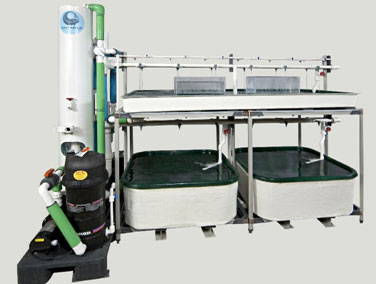UNBSJ – Marine Wet Table 2
|
Institution: |
 University of New-Brunswick in Saint-John University of New-Brunswick in Saint-John |
|
Location: |
Saint-John, New-Brunswick, CANADA |
|
Contact: |
Dr. Heather HUNT |
|
Habitat: |
Saltwater |
|
Type of rearing unit: |
UNBSJ – Marine Wet Table 2 |
|
Unit description: |
|
|
Mandate: |
|
UNBSJ – Marine Wet Table 2
- Each item of equipment (pump, filter, chiller, etc.) which is used in the REBF (Recirculation with Biologic Filtration) units is described in the technical information provided by its supplier. The information can be found filed by subject in the blue folder. Refer to these files for a description of the maintenance necessary to keep the various pieces of equipment in proper working order. Warranty information is also presented in the files.
- Within the wet table unit, the water circulates once it has passed through the cartridge filter by two loops. The centrifugal pump discharges simultaneously into the biologic filter loop, and the rearing tank loop. Subsequently, the effluent from each loop flows by gravity into the pump sump, at which point the two loops would have rejoined. The advantage of having two distinct recirculation loops is that they enable independent temperature and water quality control;
- Recirculation rate is of 99.9% of flow and make-up rate is only about 0.15 lpm;
- The system can be dismantled for cleaning and sterilisation of all waterways;
- Can operate in both fresh or saltwater;
- From the AquanitTM Tricking biofilter, treated water is pumped directly to the rearing tanks. Maximum daily food input is 0.5 kg dry feed per biofilter;
- Operation at high aquatic organisms loads optimised by the presence of our Counter-current Oxygen Saturator for rapid diffusion of oxygen-enriched air through the recycled water;
- The REBF Module is linked to three insulated rearing tanks, with a working capacity of approximately 396 L in the case of lower tanks (Swedish tanks) and 360 L for upper tank (raceway tank);
- Flow rate for the raceway tank is a maximum of 25 litres/min. Tank can have a turnover time of 0.25 hr (e. one water exchange every 15 min). Flow rate per Swedish tanks is a maximum of 20 litres/min. Tank can have a turnover time of 0.33 hr (i.e. one water exchange every 20 min). This rapid turnover time allows for the maintenance of an excellent quality of water and oxygen levels throughout the rearing period (e.g. In situations of rapidly increasing biomass). ;
- The tanks are supported within two double-decked stands, which are constructed of high-strength fibreglass beams. The stands can be entirely dismantled and moved by two adults. The upper deck can accommodate the raceway and there is sufficient space between the upper and lower decks to enable the operator to work comfortably with two Swedish tanks. The tanks may be accessed from the outer sides of the stand.



